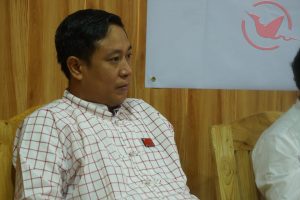Min Kyaw Zayar Oo is a central executive committee member of the Mon National Party, and is a secretary member of the Union Peace Dialogue Joint Committee’s (UPDJC) political party faction. Mon News Agency reporter Mi Paing Non met with Min Kyaw Zayar Oo in Mawlamyine.

Q: Can you talk about the challenges that the UPDJC has faced while trying to convene the national-level political dialogues?
A: Yes, there are many challenges… For example, the UPDJC’s guidelines include holding nationality-based [national-level political dialogues]. But the [nationwide ceasefire agreement] hasn’t been signed yet in Mon State, for example. So that means that Mon State is unable to hold a national-level political dialogue. And how about the Bamar people in the areas where the ceasefire has been signed? The Bamar people don’t have ethnic armed groups. We have many technicalities like this.
Q: What about the challenges at UPDJC meetings?
A: In the past, the State Counsellor has only attended the meetings between 10am to noon. She only comes for two or three hours so we have to line up all the information in order for her to make important decisions. She gives us time to explain the meaning of some points. Then after the secretary group holds the meeting, the members have to explain the information and decisions to their own groups. We have to call a meeting with 23 political parties to explain the reasons why these points have come up. The [ethnic armed organizations] also hold their own meetings. But for the government, I don’t know whether they have time or not [to explain to their juniors].
Q: Among the 37 points in the Union Accord of the 21st-Century Panglong Conference, which points are the most difficult ones for your group?
A: These 37 points are very general. More specific policies will have to emerge under these points. For example, one of the points states that regions/states must be established, but policies need to be drafted to describe how the states and regions should be established.
Q: How far has the peace process reached?
A: Some people believe there has been development in the peace process. Compared to the past, there has been development, but I would describe it as a shift. We don’t know when [the peace process] will end or how long the process will take. At the first conference held during U Thein Sein’s administration, the duration has forecast at three to five years. The existing [National League for Democracy-led] government only has three years left in its term now so it won’t be able to start a new path for the peace process. It can only follow the existing path. This NCA [nationwide ceasefire agreement] is the only path. So, we need to do our best to amend it as best as we can.

